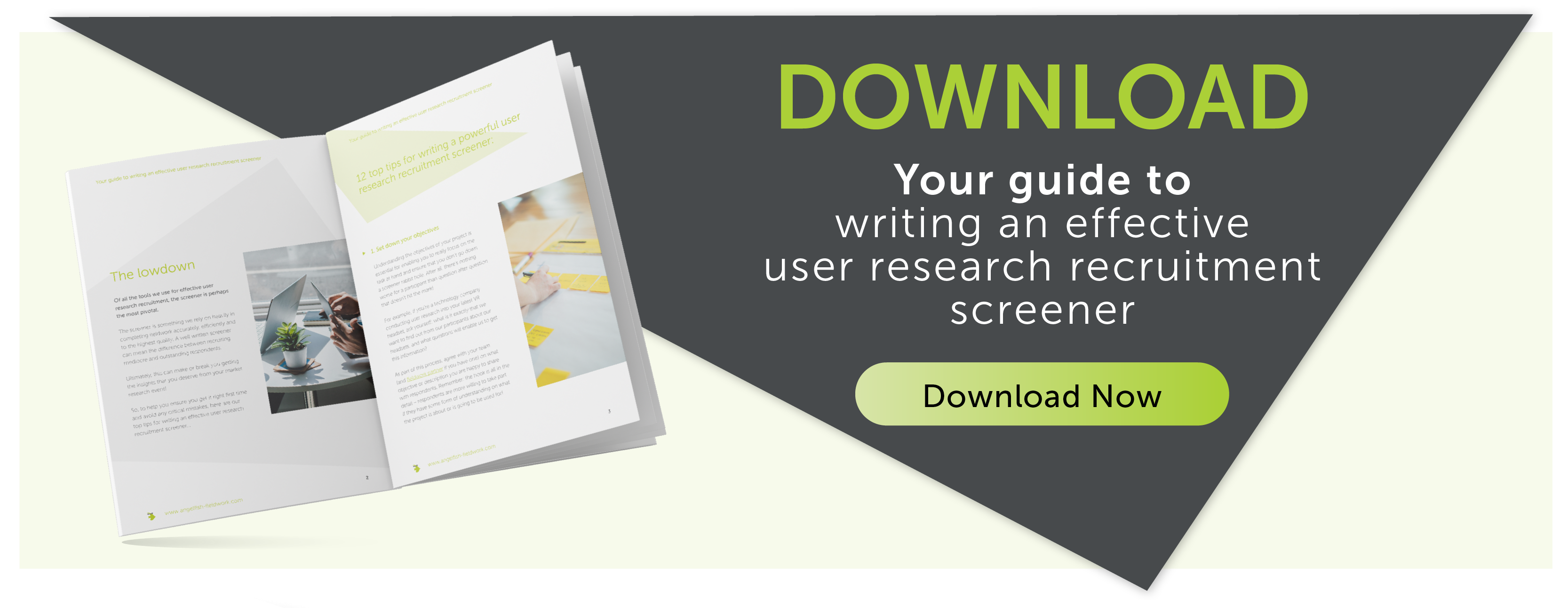
7 Questions Every User Research Recruitment Screener Should Include
There’s no denying that writing a user research recruitment screener can be a bit of a complicated process.
In fact, as any user research recruitment agency worth their salt will tell you, a lot of consideration needs to go into deciding which questions to include in your screener so you can ensure you recruit the best possible participants for your research.
So, if you’ve got a user research study coming up and are struggling to write a recruitment screener, we’ve outlined seven questions you should include so you can make sure it’s as impactful as possible.
Ready to get started? Let’s dive in!
7 important questions you should include in your user research recruitment screener
1. General demographics questions
As with any research study, firstly you’ll need to ensure that your user research recruitment screener includes questions about your participants’ demographics. This includes questions around gender identity, age, where they live, ethnic background, job title and so on.
This information will help you to establish whether your prospective participants are representative of your target audience. For example, if you were looking to test a new photo editing app aimed at Millennials, you’d need to confirm that your participants were born between 1981 and 1996.
Plus, in order to ensure you have a diverse sample, you should find respondents from different ethnic backgrounds and gender identities to achieve a fully representative sample.
Top tip: Make sure to ask your demographic questions first, so you can be sure you’re not wasting people’s time if they don’t qualify.
2. Check for potential bias
Next up, you’ll need to find out if your potential participant or their family has worked in a similar organisation to yours or has worked with similar or competitor products to eliminate the possibility of bias.
Going back to our previous app example, if one of your participants has a family member that also develops apps, or perhaps works in digital photo editing, the participant may know some information that could influence the way that they interact with your app during the research.
Sure, most screeners will ask whether the participant or their family have worked in advertising, marketing, or market research. But by going one step further and asking whether they have worked at similar organisations, you can be completely sure you’re eliminating bias and that you recruit the best sample possible.

3. Brand likes and dislikes
It’s also super useful to gain an understanding of the other products and services your prospective participants are using.
For example, you may want to recruit participants who use products and services from your main competitors so you can find out how to make your product even more appealing. What do your prospective users like about your competitors that you might not have seen yourself?
Whilst you’re at it, it’s also a good idea to include the name of your own brand so you can screen out any participants who have no interest in or dislike your brand, so your research findings aren’t skewed.
4. Technology capability
We know, this question might sound obvious and relatively straightforward, but trust us: it’s a really important one. Think about how many interviews you have started where the recruit doesn’t have the correct equipment, or they don’t know how to use the software. We bet it’s quite a lot.
Basically, if your participants don’t have access to the devices you need them to use or are not comfortable using the devices or software you provide them as part of the study, they won’t be suitable to take part.
Knowing this (and including an over-recruit too) will help ensure everything runs as smoothly as possible and save you the time and resources needed to recruit participants at the last minute on the day.
5. Accessibility needs
In today’s world, there’s no excuse for not being accessible, and addressing the accessibility and inclusivity needs of your participants is more important than ever before.
Going back to our photo app example, if you’re going to address any accessibility needs, you need to start by asking whether your potential participants have any accessibility needs around handheld device usage.
This means that not only can you ensure you’re recruiting a representative sample, but that you can make any necessary provisions for your participants to take part too.
Plus, you can also gain an understanding about how you can make your product or service more user friendly and inclusive to those with accessibility needs as well.

6. Behavioural demographics
Did you know that establishing behavioural demographics for your user research is just as important as establishing their personal demographics?
Yep, confirming behavioural demographics allows you to choose participants based on their day-to-day activities, personal values, and how they relate to your product so you can have a well-rounded view of who’s taking part in your research.
Going back to our trusty millennial photo app example, you could ask the question “which of the following statements best describes your phone photography and editing activity?” with answer statements such as:
- I take and edit photos on my phone frequently throughout the day
- I take and edit photos on my phone no more than once a day
- I take and edit photos on my phone between 1-3 times a week
- I don’t really take or edit photos on my phone
Then, depending on whether you want to recruit participants who use their phone to take and edit photos frequently or infrequently, you can narrow down your respondent pool accordingly.
7. Creative questions
Finally, including a creative question or two in your screener related to your topic area is another great way to assess if your participants are the right fit for your research.
Using our app example, you could ask a question such as: “If I put an apple down on a table in front of you and asked you to take and edit a photo of it, how would you go about this?”
If your prospective participant described positioning the apple in an interesting way, taking the photo from a specific angle, and possibly using different filters or colour editing, they’d be the ideal participant to take on board, whereas if they just said they would grab their phone and take a quick photo, they’re probably not the right respondent for you.
Creative questions like this can be quite tricky to include in a screener, though, which is why here at Angelfish we often save these types of questions for our validation calls. We can then easily assess if they are going to be the right fit for your project.
Why should I work with a user research recruitment agency to develop my screener?
While writing your own user research recruitment screener can be quicker in the short term, the fact is that a user research recruitment agency will have years of experience and up-to-date expertise behind them to ensure that your screener is up to scratch.
This means that you’ll have complete peace of mind that your participants will be of the highest possible quality and provide you with truly representative insights that can help you to enhance and develop your products and services.
Need further help or screener advice?
If you’re looking for additional help and advice with your user research recruitment screener, you’ve come to the right place! Here at Angelfish Fieldwork, we can not only help with your screener, but with the whole recruitment process too.
In fact, we’ve got over 40 collective years of experience as a user research recruitment agency that we can bring to the table, which means there’s no one better placed to help your research go off with a bang!
So, from screeners to validation, if you’d like to learn more about how our team of research recruitment superstars can help with your next project, don’t hesitate to get in touch for a chat – we'd love to see how we can help!
Alternatively, in the meantime, why not check out our ultimate guide to writing an effective user research recruitment screener for more top tips and expert advice.














